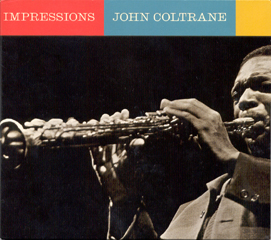
Impressions is an album of live and studio recordings by jazz musician John Coltrane, released by Impulse! Records in July 1963.

Live At The Village Vanguard Again! is a live jazz album by saxophonist John Coltrane. Recorded in May 1966 during a live performance at the Village Vanguard jazz club in New York City, the album features Coltrane playing in the free jazz style that characterized his final years. The lineup features Coltrane's quintet, with Coltrane on tenor and soprano saxophones, bass clarinet, and flute, Pharoah Sanders on tenor saxophone and flute, Alice Coltrane on piano, Jimmy Garrison on bass, and Rashied Ali on drums, supplemented by Emanuel Rahim on percussion. It was the quintet's only official recording released during Coltrane's lifetime.

Live in Japan is a live album by American saxophonist John Coltrane, recorded for radio broadcast during his only Japanese tour in July 1966 at two Tokyo venues, Shinjuku Kosei Nenkin Hall and Sankei Hall. The recordings feature his last group, a quintet featuring Coltrane, his wife/pianist Alice, saxophonist/bass clarinetist Pharoah Sanders, bassist Jimmy Garrison and drummer Rashied Ali.

Carlos Ward is a funk and jazz alto saxophonist and flautist. He is best known as a member of the Funk and disco band BT Express as well as a jazz sideman.
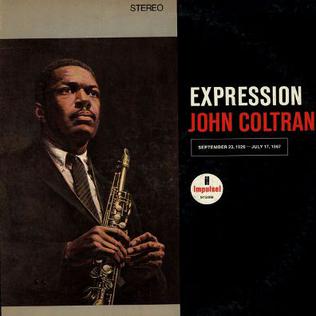
Expression is an album by jazz saxophonist John Coltrane, recorded in early 1967 and released in late September of that year, around Coltrane's birthday, and two months after his death. This was the first posthumous release of a Coltrane recording, and the last album he personally authorized.

The Major Works of John Coltrane is a compilation album by jazz musician John Coltrane, released in 1992 by GRP Records. It features extended compositions, all recorded in 1965 with expanded ensembles, and originally released by Impulse! Records on Ascension, Om, Kulu Sé Mama, and Selflessness: Featuring My Favorite Things. Both editions of Ascension are included.

First Meditations (for quartet) is an album by John Coltrane recorded on September 2, 1965 and posthumously released in 1977. It is a quartet version of a suite Coltrane would record as Meditations two months later with an expanded group. Along with Sun Ship, recorded a week earlier, First Meditations represents the final recordings of Coltrane's classic quartet featuring pianist McCoy Tyner, bassist Jimmy Garrison, and drummer Elvin Jones.
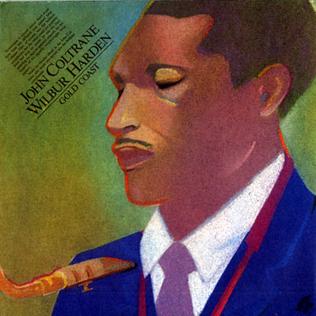
Gold Coast is a compilation album by jazz musicians John Coltrane and Wilbur Harden, released in 1977 just after Dial Africa: The Savoy Sessions, featuring pieces recorded during the two 1958 sessions that produced Tanganyika Strut and Jazz Way Out.

The John Coltrane Quartet Plays is an album by jazz musician John Coltrane, recorded in February and May 1965, shortly after the release of A Love Supreme.

Kulu Sé Mama is an album by jazz musician John Coltrane. Recorded during 1965, it was released in January 1967 as Impulse! A-9106, and was the last album released during Coltrane's lifetime.
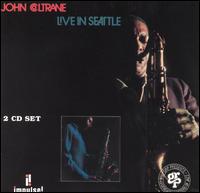
Live in Seattle is a live double album by jazz saxophonist John Coltrane, recorded in 1965 and released posthumously in 1971 on the Impulse! label. The album consists of a set played by Coltrane's quartet at The Penthouse on September 30, 1965. Along with the later-released A Love Supreme: Live in Seattle, recorded two days later at the same club, they are the only officially released live recordings of Coltrane's six-piece lineup from late 1965. The original double LP issue was expanded to 2 CDs for the reissue.

Live in Paris is an album by jazz musician John Coltrane originally issued as 2 separate volumes in 1974 by BYG Japan and later reissued on CD by Charly Records.

Live in Antibes is a live album by jazz musician John Coltrane that was released in 1988 on the France's Concert label.

Selflessness Featuring My Favorite Things is a posthumous album by jazz musician John Coltrane, released in 1969. The album juxtaposes two tracks recorded live at the 1963 Newport Jazz Festival with a single track ("Selflessness") recorded in a studio in Los Angeles in 1965.

Cosmic Music is a jazz album by John Coltrane and Alice Coltrane released after John Coltrane's death. John Coltrane only plays on two tracks, "Manifestation" and "Reverend King".

Offering: Live at Temple University is a live album by John Coltrane recorded in 1966 and released posthumously by Resonance Records on September 23, 2014, Coltrane's 88th birthday. The album won the Grammy Award for Best Album Notes and was well-received by critics. Proceeds from the album benefit the John Coltrane Home.
"26-2" is a musical composition written by American jazz musician John Coltrane. The song was recorded by Coltrane in 1960, but it released ten years later by Atlantic Records on an album entitled The Coltrane Legacy with a rhythm section composed of McCoy Tyner on piano, Steve Davis on bass, and Elvin Jones on drums. The composition itself is a contrafact of Charlie Parker's tune "Confirmation", with harmonic alterations to the original chord changes used by Coltrane in a number of his compositions. This harmonic modification is commonly known as Coltrane Changes, which have been most notably used in Coltrane's "Giant Steps". "26-2" is one of several contrafacts by Coltrane, others including "Countdown", a contrafact of Miles Davis's "Tune Up"; and "Satellite" from the album Coltrane's Sound, which is based upon the chord progression of "How High the Moon". Coltrane plays the first statement of the melody on tenor saxophone and switches to soprano saxophone for the last statement of the melody on the recorded version.

Donald Rafael Garrett was an American jazz multi-instrumentalist who played double-bass, clarinet, and flute.

Dear Old Stockholm is a compilation album by jazz musician John Coltrane released by GRP and Impulse! in 1993. The music, which was recorded on April 29, 1963 and May 26, 1965 at Van Gelder Studio in Englewood Cliffs, NJ, features Coltrane's quartet with Roy Haynes substituting for Elvin Jones on drums.
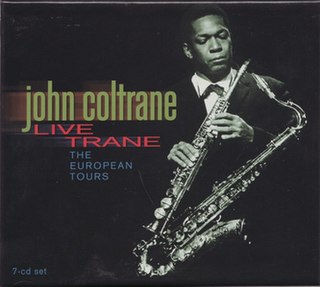
Live Trane: The European Tours is a 7–CD compilation album by American saxophonist John Coltrane containing music recorded live during 1961, 1962, and 1963 European tours, all of which took place under the auspices of Norman Granz's Jazz at the Philharmonic programs. The album, which was released in 2001 by Pablo Records, features Coltrane on tenor and soprano saxophones along with pianist McCoy Tyner, bassists Jimmy Garrison and Reggie Workman, and drummer Elvin Jones. In addition, Eric Dolphy is heard on alto saxophone, bass clarinet, and flute on a number of tracks.

















